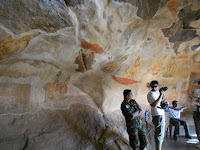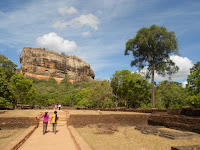2011-08-27
Tokaido Walk(15) Ejiri-Fuchu: August 27, 2011
Hot summer will soon be over (hopefully). I restarted my Tokaido Walk.
I walked from Ejiri, the 18th shukuba station from Nihonbashi, to Fuchu, the 19th.
Ejiri is in Shimizu Ward in Shizuoka city. The town is famous for its port. They have developed such industries as fish food production, wharehouse, transportation and marine related machines. It also boasts its football team (Shimizu S-Pulse), Jirocho, one of the nation’s most famous chivalrous heroes in the 19th century, and Chibi Maruko, a cute manga heroine.
Some buses are painted with Chibi Maruko-related characters.
Kusanagi, between Ejiri and Fuchu, is historically famous. Yamato Takeru, Japan’s legendary hero in the country’s founding era (about 2000 years ago), had a famous fight here. A shrine is built to commemorate the event.
Houses spread along Tokaido here. I also found many horticulture farms here.
2011-08-13
Sri Lanka(3) Nature & Animals (off off Tokyo): August 7-12, 2011
I always find animals during my 1 week stay in Sri Lanka.
I enjoyed safari 3 times.
My first safari was at Minneriya National Park near Polonnaruwa in central Sri Lanka. The park is famous for elephants.
I found about 100 elephants gathering around water pools (for drinking water and taking bath).
Some group came out of bushes and moved through safari jeeps into green fields. Baby elephants ran hard to follow adults.
It was so impressive.
My second safari was at Yala National Park in south east coast. It was famous for peacocks. Hundreds of them were walking elegantly.
I also saw buffaloes, wild hugs, deer, crocodiles, mongooses and other animals and birds.
I also enjoyed a boat safari at Ahungalla, south west coast. My small boat moved through a mangrove jungle. Birds flied over the trees. I was surprised when I found big water lizards, which were around 1.5 meter long, swimming in the water.
Another impressive experience was a visit to elephant’s orphanage at Pinnawala near Kandy. Around 100 elephants are cared at the center.
 The elephants are taken to a nearby river twice a day for bathing. They walk in a public road on the way to and from the river.
The elephants are taken to a nearby river twice a day for bathing. They walk in a public road on the way to and from the river.People and dogs were also on the road when I arrived there.
Marine turtles are also cared in a protection center near Bentota, east coast city. Baby turtles were swimming in pools. Children enjoyed seeing (and sometimes touching) them.
They will be released to the Indian Ocean soon.
Only one turtlr out of 100 will grow up and return to the coast, acording to a staff member.
I saw dogs and cows everywhere (including in the public roads and fields) in the country. Even elephants walkes in the road.
I also found monkeys and squirrels in some places.
The Indian Ocian was beautiful. The sea was blue and the palm trees covered the coasts.
The waves made heavy sounds and I felt vibrations when I was sleeping in a sea-coast hotel.
Sri Lanka(2) Culture & History(off off Tokyo): August 7-12, 2011
I could have an opportunity to Perahera festival in Kandy during my stay in Sri Lanka. I was lucky.
Perehera started as a local festival to cerebrate local gods about 2000 years ago. But it was connected with Buddhism Temple (Temple of the Tooth) and became a nation’s important event in the 18th century.
The festival continues two weeks every year. Hundreds of elephants and dancers walk across the streets and show their performances.
The performance was scheduled to start in the evening, but thousands of people were already waiting on the road sides when I arrived Kandy in early afternoon.
The march and performance continued about three hours. The elephants moved in order, which was a big surprise to me.
I visited all six world cultural heritage in Sri Lanka. They are:
Sacred City of Anuradhapura
Sri Lanka's first capital (BC 380-AD century). Became World heritage in 1982.
Famous bodhi tree (lime tree) is planted. Buddha attained enlightenment under a tree in Buddha Gaya in northern India in the 4th cantury B.C. The branch of the tree was imported into Sri Lanka in the 3rd century B.C. and was planted here. The original tree in India has already been dead.
There are also histrical important stupas in the city.
Ancient City of Polonnaruwa
Sri Lanka's second capital (10-12 century)
Famous Buddha scalptures are curved in a hige rock. The lying one is 14 meter long.
Sacred City of Kandy
Sri Lanka's 3rd and last capital(15-19 century)
Perahera festival is held here. Temple of the Tooth keeps Buddha's tooth.
Ancient City of Sigiriya
Sigiriya is the ruin of a rock fort (or Palace) in a jungle. It was a tenporal capital of the country (only 11 years) in the late 5th centyry. The history of Singiriya is connected with a tragic (mad?) king.
 King Kasyapa killed his father and became a king and moved tha apital from Anuradhapura to Singiriya. But he was later defeated by his brother and killed himself.
King Kasyapa killed his father and became a king and moved tha apital from Anuradhapura to Singiriya. But he was later defeated by his brother and killed himself.The palace was decolated with beautiful paintings. The pictures of half-naked women are especially famous.
Only 18 paintings out of about 500 remain.
Golden Temple of Dambulla
There are five temples in a stone mountain in Dambulla.
Old Town of Galle and its Fortifications
Galle originally developed as a port to be used for trades with Arabic people. Portuguese established a fort in the late 16th century. The fort was controlled by Dutch people in the 17th centyry. The ruler changed to British later.
The indian Ocean spreads in front of the fort.
Sri Lanka(1)Life & Society(off off Tokyo): August 7-12, 2011
I visited Sri Lanka to enjoy my summer vacation. It was my first visit of the country.
The country has 8 world heritages. It also attracts tourist with its beautiful beaches and rich nature. It is true, but I was also interested in its society and people’s life.
Traffic signals are rarely seen even in big cities like Colombo.
Three wheelers run amid automobiles. They are main players in transportation in rural towns and villages. Dogs and cows walk in the streets.
It seemed that the civil war (1983-2009) had seriously hit the economy and had delayed the developments of the society.
Still changes are seen.I found mobile-phone billboards and shops everywhere in the country (even in small mountainous villages). Cell phone is becoming "must" thing for people and even elementary school boys and girls held them (taking them to school is banned), according to my tour guide.
The country is green rich. Water is also affluent.
I saw coconut palm trees field in various places.
Growing rice is popular in lowland.
Tea plantations spread in moutan areas. I visited Mackwoods tea plant near Nuwar Eliya. The plantation was developed by William Mackwoods in the mid 19th century. I was impressed with his venture spirit (along with colonization history).
Herb plantations are also developed in mountain areas.
I saw many posters of political parties and politicians in the towns. President's poster is mostly stand out.
I could not help but laugh when I found an election campaign advertisement drawn on a rock with white paint at Rawana Ella Falls, one of the nation’s most famous (and beautiful) falls. It is of course banned.
Subscribe to:
Posts (Atom)































